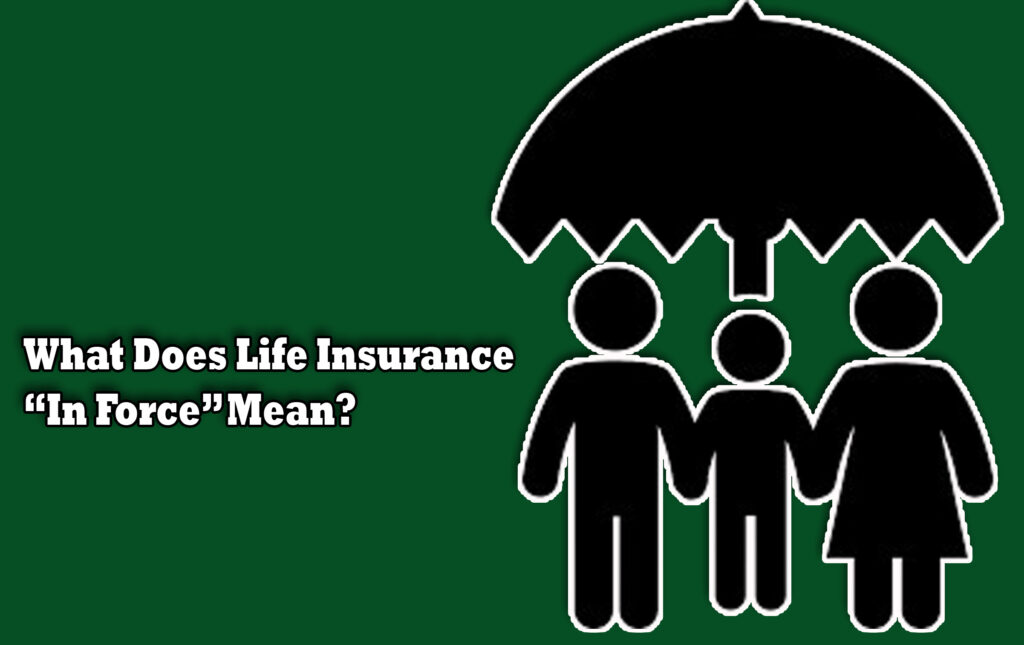What does life insurance “in force” mean? We all know, life insurance is a powerful tool designed to provide financial security to your loved ones in the event of your death.

It can help pay for funeral costs, cover outstanding debts, replace lost income, and offer peace of mind to those left behind.
However, having a policy isn’t enough; what truly matters is whether the policy is “in force.” This term may sound technical, but it plays a critical role in determining whether your insurance coverage is active and enforceable when it matters most.
When a life insurance policy is “in force,” it means the policy is active, valid, and offering the coverage promised by the insurer. The insured has paid the required premiums on time, and all conditions of the contract are being met.
If the policyholder dies while the policy is in force, the insurance company is obligated to pay the death benefit to the designated beneficiaries.
What Does “In Force” Mean in Life Insurance?
A life insurance policy being “in force” means it is currently active and in good standing. This status simply shows that the policyholder is meeting all requirements especially in premium payments, and the insurer is bound to fulfill its obligations under the contract.
Essentially, the policy is functioning as intended and can provide the agreed-upon death benefit in the event of the insured’s death.
Why Maintaining an In-Force Policy Matters
Keeping your life insurance policy in force is the only way to ensure your loved ones receive the protection you are planning for. Life insurance isn’t something you buy and forget about; it’s a living contract that must be maintained.
Here are a few reasons why maintaining an in-force policy is essential:
- It ensures that the death benefit is payable. So, if the policy lapses, beneficiaries will receive nothing.
- Letting a policy lapse may require a new application, medical exam, and higher premiums.
- Some policies offer living benefits or investment options that are only accessible if the policy is active.
By keeping your policy in force, you would be honoring the financial safety net you’ve built for your family and securing the benefits you invested in.
How to Keep a Life Insurance Policy In Force
As a policyholder, you must be actively staying on top of your responsibilities as it is a vital key to keeping your coverage active. Most insurers provide multiple options and reminders to help ensure your policy remains in force.
Here are some actionable steps to take when it comes to keeping your insurance policy in Force:
Pay Premiums On Time: The most basic requirement to keep a policy in force is paying premiums consistently and before the due date. Many companies offer automatic payments, which reduce the chance of forgetting.
Understand the Grace Period: Most policies include a grace period (typically 30 days) after the due date. If you miss a payment but make it during this window, your policy still remains in force.
Avoid Policy Loans That Exhaust Cash Value: With whole or universal life policies, borrowing against your policy is possible. However, if the loans and interest deplete the cash value, the policy can lapse.
Monitor Your Policy Regularly: You must regularly check your policy status annually or during major life events. Also, always confirm that your premiums, beneficiaries, and coverage amounts are up to date.
Maintain Communication With the Insurer: Keep your contact information updated and notify your insurer about major changes in your health, occupation, or financial status if required.
What Happens When a Policy Is No Longer In Force?
When a life insurance policy loses its “in force” status, it essentially becomes inactive or void. The insurer is no longer obligated to pay the death benefit, and the policyholder may have to take specific steps to reinstate coverage. In this scenario, you are left with:
Lapsed Policy: A lapsed policy means the coverage has ended due to non-payment or policy violations.
Canceled or Surrendered Policy: If the policyholder chooses to cancel or surrender the policy, the coverage permanently ends. Reapplying in the future could result in higher costs due to age or health changes.
Policy Maturity: Some permanent life insurance policies mature when the insured reaches a specific age (e.g., 100 or 120). At maturity, the policy may pay out its face value, and coverage ends.
To avoid these situations, it’s best to proactively manage your policy to keep it in force as long as needed.
Frequently Asked Questions
How Can I Check If My Life Insurance Policy Is In Force?
You can verify your policy status by contacting your insurer or logging into your online account. Also, you can look for recent payment history, policy statements, or confirmation letters.
Can a Policy Be Reinstated After It Lapses?
Yes, most insurers do allow reinstatement within a specific period. Nevertheless, you’ll need to pay missed premiums and possibly provide proof of insurability.
What Does It Mean If A Policy Is “paid up” But Still In Force?
A “paid-up” policy means no further premiums are due, but the coverage remains active. This often applies to whole life insurance when the policyholder pays enough into the policy early on.



